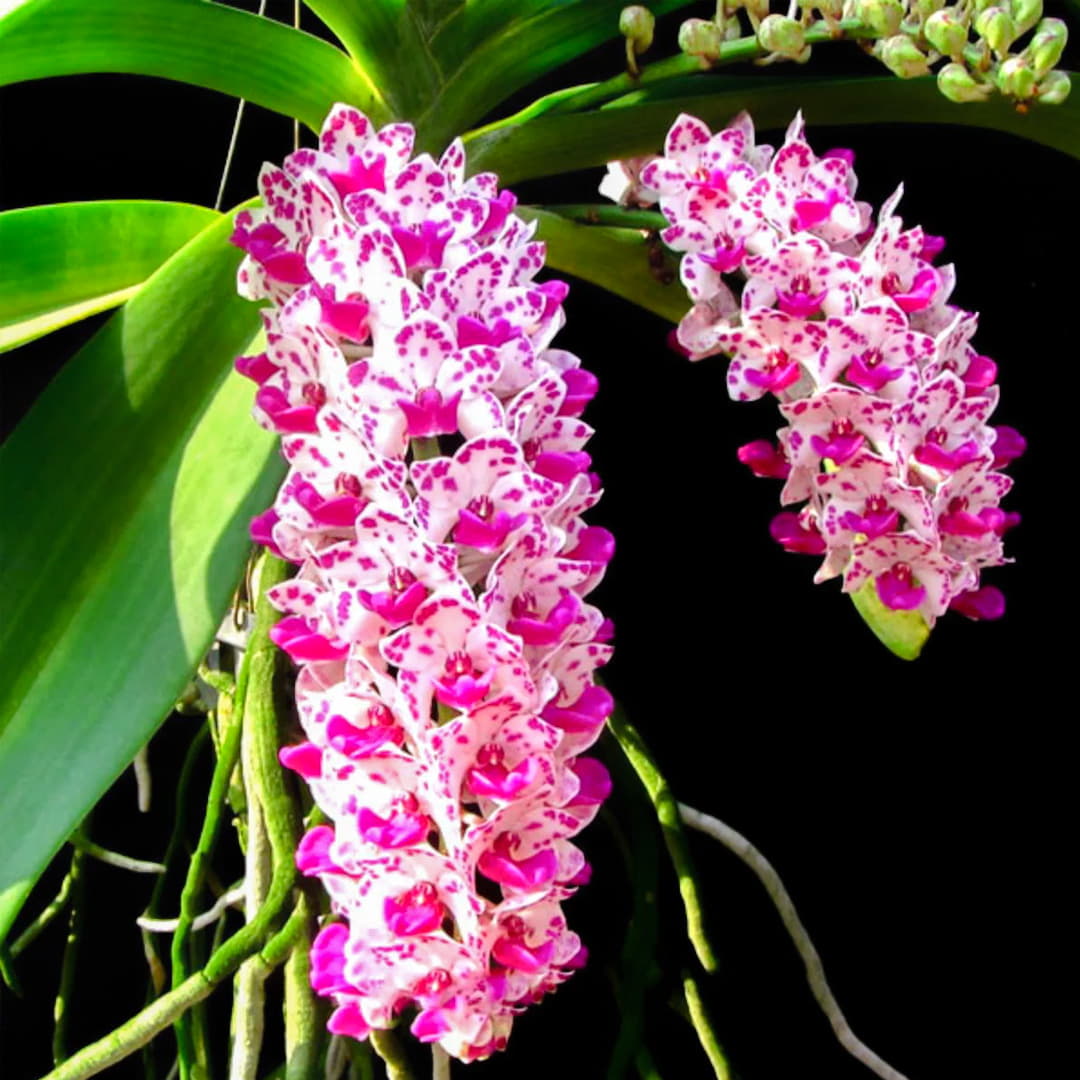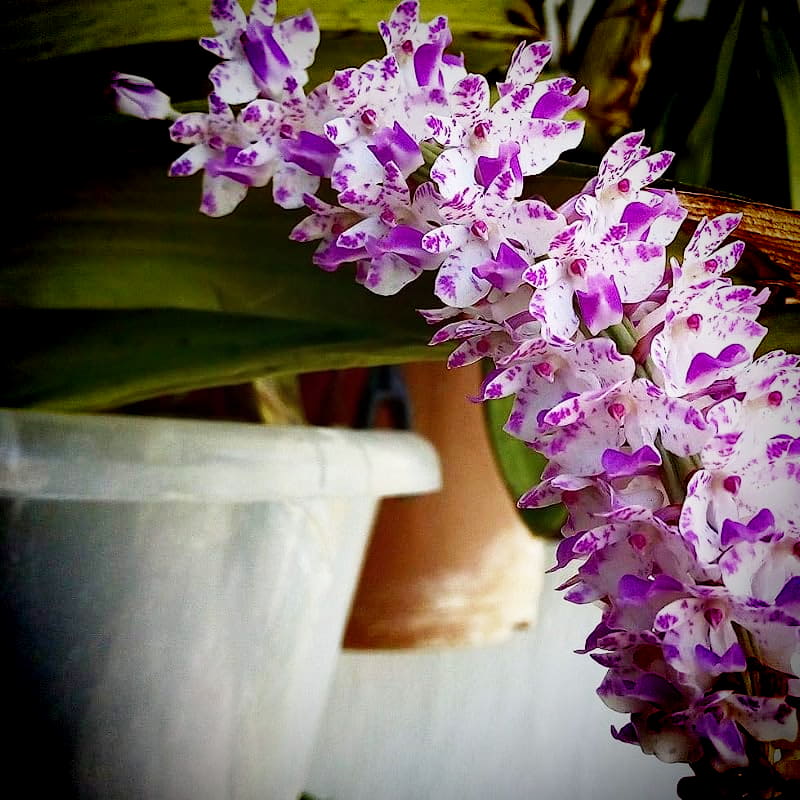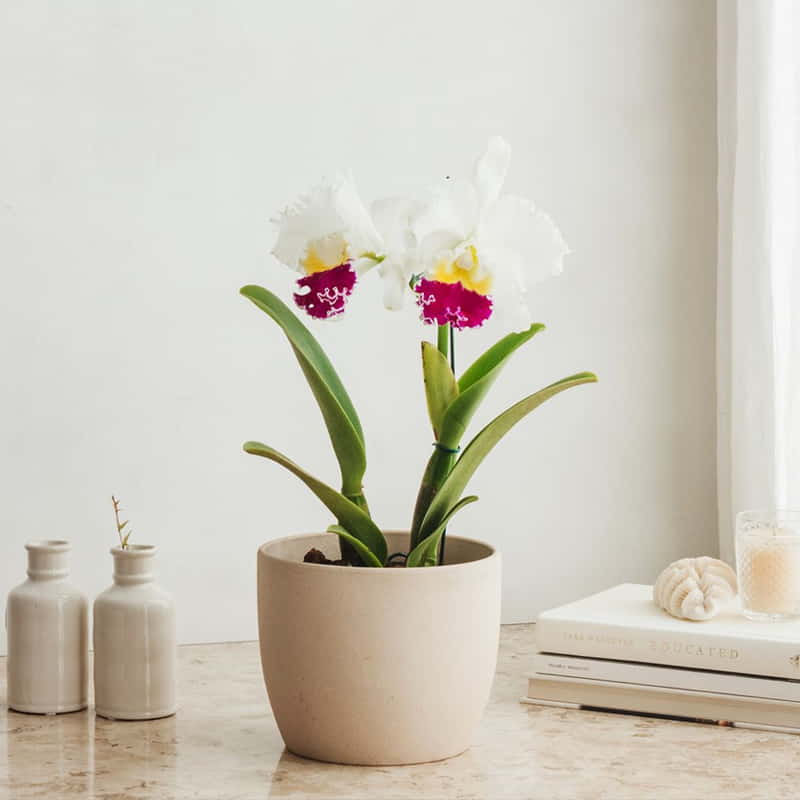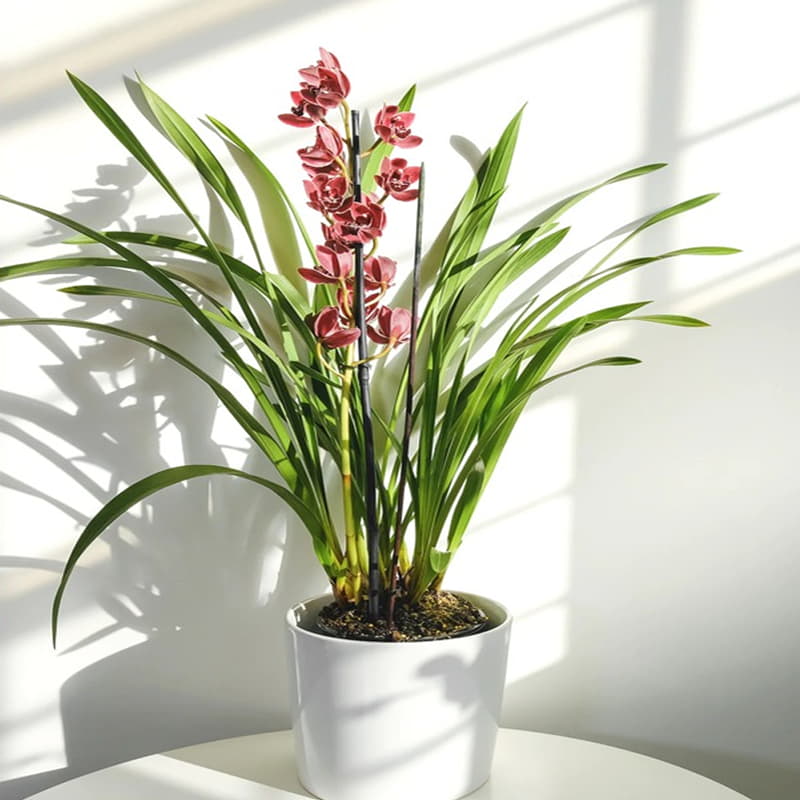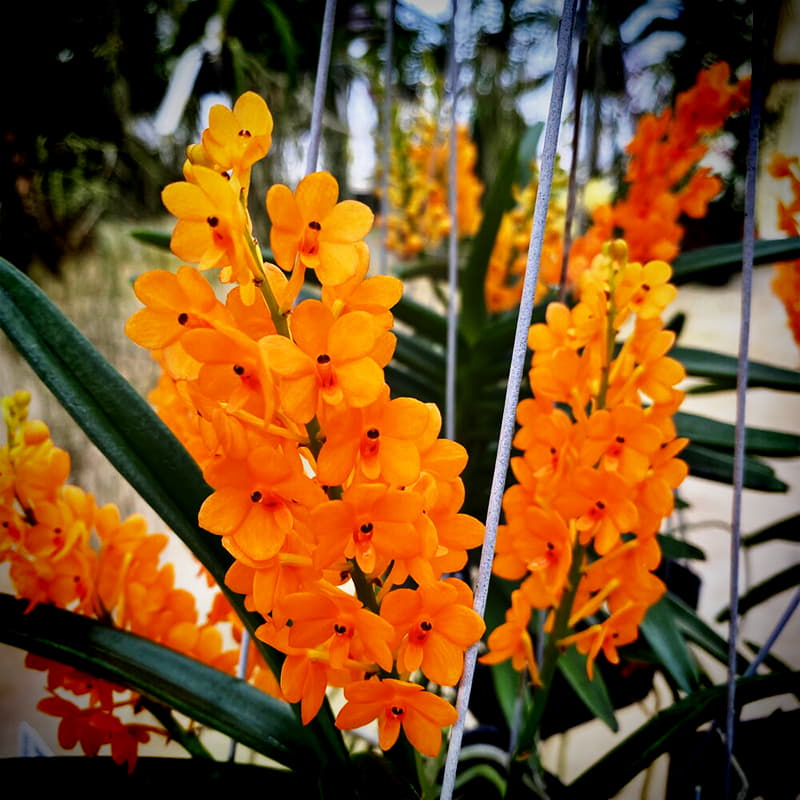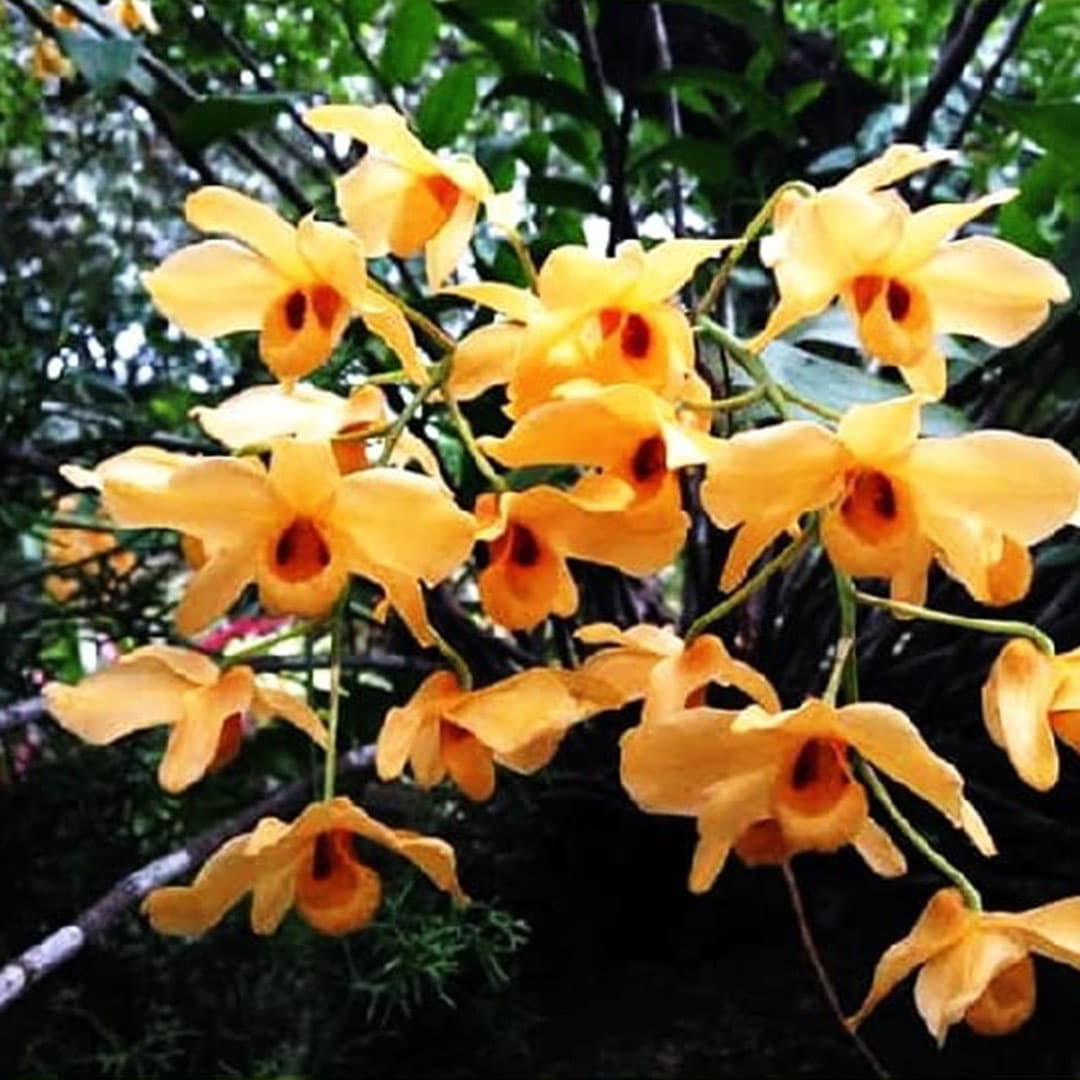Image(s) are for reference. Actual product might vary in some aspects like shape, size etc, from the one given in the image(s). However, we ensure what you get is close to the image(s) and of high quality. Our target is to deliver a healthy and well built plant. So relax after ordering and wait for an excellent delivery from Bharat Vumi that will bring smile on your face.
Package- A healthy Vanda Foxtail Orchid Plant (Without pot)
Plant Description:
Common Name-Foxtail orchid
Scientific Name- Rhynchostylis retusa
Family- Orchidaceae
Origin-Foxtail orchid is native to countries such as India, Nepal, Bangladesh, Myanmar, Thailand, and Vietnam.
Rhychostylis retusa commonly called as foxtail orchid is a marvelous orchid species admired for its unique inflorescence resembling like a fox tail. The species features long arching spikes full of small flowers of different attractive colours like pink, purple, white. The species thrives well in warm humid environments and require regular watering to induce stunning floral beauty.
Growing Conditions-
1.Potting Mix- Royal potting mix is ideal for foxtail orchid. The mix is composed of Pine bark, Charcoal, Pumice rock, Leca balls, Orchid Antifungal and Orchid Fertilizer.
2.Watering-Vanda orchids should be watered regularly to keep the roots hydrated during its growing period. Water the plant thoroughly and let the excess water drain away. Allow the roots to dry out slightly before the next watering.
3.Temperature-Vanda orchids prefer warm to intermediate temperatures.
Daytime temperature between 24℃-32℃ and night-time temperature
between 15℃-21℃ are suitable for the growth of Vanda
orchids. They can tolerate higher temperature level also.
4.Humidity-These orchids prefer high humidity level, between 50%-80%. To increase the humidity grouping all the plants together to create a microclimate. These orchids thrive in bright, indirect light. They require 4-6 hours of bright, fileted light per day. A location with bright morning sun and partial shade in the afternoon is suitable for their growth. Good air circulation is crucial for Vanda orchids.
5.Light Requirements- Foxtail orchid can be grown outdoor under the shade of any big tree or can be grown indoor where it gets ample sunlight. Avoid exposing them to direct sunlight for a long time. It will result in burning of leaves.
6.Fertilizer requirements-Regular feeding with a balanced orchid fertilizer is important for the growth and flowering of Vanda orchids. Apply a diluted orchid fertilizer(Seaweed Liquid Fertilizer) every 2-3 weeks during spring and summer. Reduce fertilization during winter as the plant requires a rest phase.
7.Flowering-Foxtail orchid typically blooms during spring and summer, but some varieties may bloom at different times throughout the year. The orchid produces inflorescence of small vibrant coloured flowers which lasts for several weeks to few months.
8.Important Diseases -Orchids can be susceptible to various diseases-
a. Bacterial soft and brown rot- This disease occur when the orchid plant is exposed to excess moisture. Symptoms include water soaked mushy lesions on leaves, stems and roots.
b. Bacterial brown spot- Symptoms include brown spot on leaves, dark brown lesions on pseudo bulbs and stems which become soft an mushy in severe cases.
c. Black rot- Symptoms include black necrotic lesions on stem, leaves and flowers.
d. Fungal rots-Leaves and pseudo bulbs become yellow, shrivelled, thin and twisted and new growth is progressively smaller. In severe condition plants become wilted and death of the plant takes place.
e. Fungal wilt- Infected leaves become thin, yellow, shrivelled or wrinkled and eventually die.
f. Leaf spot- Leaf spot can be seen as burning of leaf tip or dark brown patches or circular, irregular spots or dark elongated purple lesions.
* Avoid overhead watering or splashing water on leaves, maintain proper drainage and improve air circulation around the orchid plant to prevent the spread the these diseases. Isolate or discard severely infected plants. Spray orchid antifungal to control the diseases.
9.Important Pests-
Mealy bugs- Mealy bugs are a destructive pest of most of the orchids. These small cottony insects attack the orchid plant and suck the sap from leaves and pseudo bulbs and can cause yellowing of leaves.
Aphids- Aphids causes leaf curling, stunted growth and produce honey dew which can lead to growth of sooty mold.
Thrips- Causes distorted growth, silvery streaks on leaves and deformed leaves.
Slugs and snails- They feed on tender twigs, leaves and flowers, leaving irregular holes and trails of slime.
Mites- Feed on the underside of the leaves and form webbing structure
*Good sanitation and elimination of weeds will help to prevent insect infestation .apply neem oil or spray Malathion to get rid of White fly, mealy bug and aphids. Use copper tape to prevent the entry of slugs and snails near the plants.
10.Pruning-Pruning of orchids is an important part as a part of
their maintenance to promote healthy growth, to remove dead and damaged parts,
to divide overcrowded plant and to remove old flower spikes. After blooming
prune the old flower spike to induce new flower spike.
11.Propagation-Vanda orchid can be propagated through division,
stem cuttings and Arial propagation.
Division-Separate a healthy Vanda orchid into divisions by
carefully separating the roots. Each division should have 3-4 healthy roots.
Stem cuttings- Take stem cutting with multiple nodes and
place them in a media such as sphagnum moss or perlite-vermiculite mix.
Aerial propagation- Allow the small plantlets to develop roots and leaves .Detach it from the parent plant and pot it separately.
| Type |
Evergreen , Epiphytic Flowering Perennial |
|---|---|
| Planting Time |
Spring or Summer |
| Potting Mix |
Royal Potting Mix- Pine bark, Charcoal, Pumice rock, Leca balls, Orchid Antifungal and Orchid Fertilizer. |
| Watering |
Vanda orchids should be watered regularly to keep the roots hydrated during its growing period. |
| Temperature |
Daytime temperature between 24℃-32℃ and night-time temperature between 15℃-21℃ |
| Humidity |
Prefers high humidity level, between 50%-80%. |
| Light Requirements |
Foxtail orchid can be grown outdoor under the shade of any big tree or can be grown indoor where it gets ample sunlight. |
| Fertilization |
Balanced orchid fertilizer in every 2-3 weeks |
| Flowering |
Blooms during spring and summer, but some varieties may bloom at different times throughout the year. |
| Important Diseases |
Black rot, leaf spot, fungal wilt, bacterial soft and brown rot etc. |
| Important Pests |
Aphids, Mealy bugs, Mites, Snails and slugs, Thrips |
| Pruning |
Pruning is done to promote healthy growth, to remove dead and damaged parts, to divide overcrowded plant and to remove old flower spikes. |
| Dormancy Period |
Winter |
| Propagation |
Vanda orchid can be propagated through division, stem cuttings and Arial propagation. |

